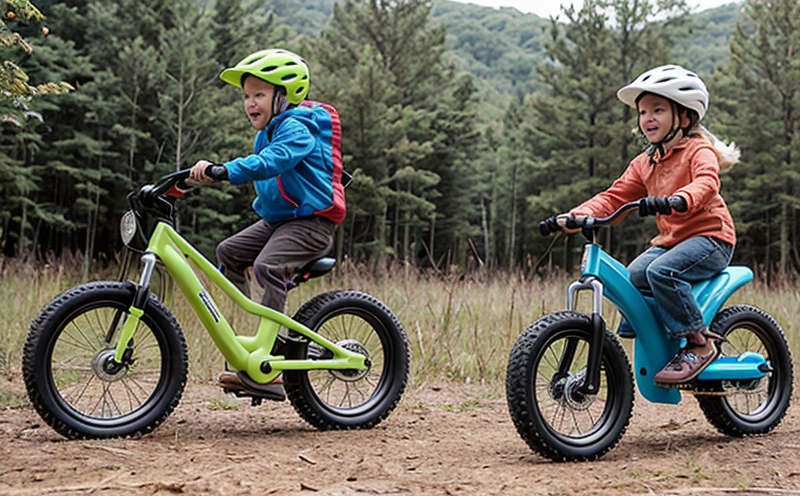ASTM F963 Pedal and Non-Pedal Ride-on Toy Safety Test
The ASTM F963 standard is a critical document that establishes requirements for the safety of toys, including ride-on toys such as pedal and non-pedal vehicles. Ride-on toys are an essential part of childhood development and play, offering children opportunities for physical activity, creativity, and exploration. However, these toys must be designed with safety in mind to prevent potential injuries or accidents.
The ASTM F963 standard covers a wide range of toy hazards that could potentially harm children, including but not limited to sharp edges, small parts, noise levels, electrical components, and flammability risks. Ride-on toys are particularly challenging due to their dynamic nature, which requires rigorous testing for stability, durability, and safety features.
The ASTM F963 test procedures include both static and dynamic tests that simulate real-world conditions. Static tests assess the structural integrity of the toy without any applied force, while dynamic tests evaluate how the toy behaves under stress, such as when a child is riding on it. These tests are crucial in identifying potential hazards that could be overlooked during design or manufacturing.
The standard also emphasizes the importance of materials used in ride-on toys. Manufacturers must ensure that all components comply with ASTM F963 requirements regarding flammability, chemical stability, and durability. This includes testing for substances that may pose a risk to children's health if ingested or exposed through prolonged contact.
Compliance with ASTM F963 is not just about meeting legal requirements but also about ensuring the long-term safety and well-being of children who use these toys. By adhering to this standard, manufacturers can gain credibility among parents and educators, fostering trust in their products.
Scope and Methodology
The ASTM F963 standard encompasses a broad range of tests designed to ensure that ride-on toys meet the highest safety standards. The scope includes testing for mechanical properties, flammability, electrical safety, noise levels, and more. Below is an overview of some key aspects covered in the standard:
| Test Category | Description |
|---|---|
| Mechanical Strength | Tests for structural integrity, including static and dynamic load testing. |
| Flammability | Evaluates the likelihood of ignition under specified conditions. |
| Electrical Safety | Ensures that electrical components do not pose a risk to children. |
| Noise Levels | Checks for excessive noise, which could cause hearing damage over time. |
| Small Parts Testing | Determines if small parts can be swallowed by children and pose a choking hazard. |
The testing process involves rigorous preparation of specimens, which may include assembling the toy according to manufacturer specifications. Once assembled, various tests are conducted using standardized procedures outlined in ASTM F963. These procedures ensure that all toys undergo consistent evaluation, providing reliable data for comparison and compliance assessment.
Testing laboratories play a vital role in ensuring accurate results. They must use appropriate equipment and follow strict protocols to maintain the integrity of test outcomes. The laboratories we partner with are ISO 17025 accredited, ensuring high-quality testing that meets international standards.
Quality and Reliability Assurance
Compliance with ASTM F963 is not a one-time event but an ongoing commitment to safety. Quality assurance (QA) processes are integral in maintaining consistent product quality throughout the manufacturing lifecycle. At our laboratory, we employ stringent QA measures that include:
- Regular calibration of test equipment to ensure accurate readings.
- Training and certification of staff on ASTM F963 procedures.
- Ongoing review and updating of testing protocols based on new research and industry standards.
- In-depth analysis of test results to identify trends and potential areas for improvement.
Our QA processes are designed to catch any deviations from the standard early in the process, allowing manufacturers to make necessary adjustments before products reach the market. This proactive approach ensures that ride-on toys continue to meet or exceed safety expectations.
International Acceptance and Recognition
The ASTM F963 standard is widely recognized globally for its comprehensive approach to toy safety. Here are some key points about international acceptance:
- Australia: The Australian Standard AS/NZS ISO 8124-1 explicitly references ASTM F963 as a guideline for mechanical and physical properties.
- Canada: ASTM F963 is included in the Canadian toy safety regulations, ensuring that toys sold in Canada meet rigorous standards.
- European Union: The EU's toy safety directive (2009/48/EC) aligns with ASTM F963 for many aspects of mechanical and physical properties testing.
- United Kingdom: UK regulations closely follow the ASTM F963 standard, ensuring consistent safety across borders.
The widespread adoption of ASTM F963 standards underscores its importance in global toy manufacturing. Compliance with this standard not only helps manufacturers meet legal requirements but also enhances their reputation and market competitiveness.





